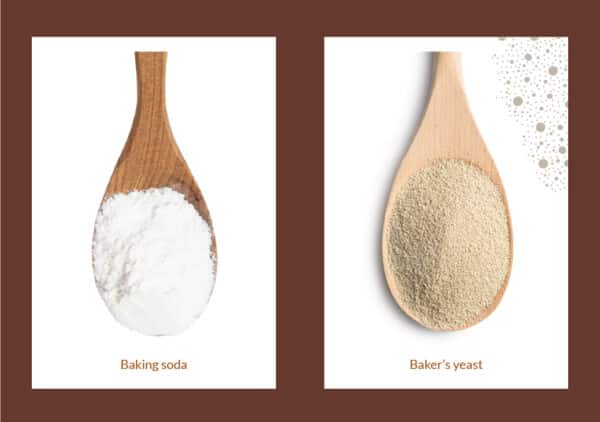Many of these drinks have health benefits and just because they are fermented does not necessarily mean they are alcoholic. Many fermented drinks are non-alcoholic (kombucha, kefir, ginger beer, …), so they can be enjoyed by the whole family. But none of these drinks can exist without a very special microorganism, yeast!
Yeast: Fermentations Best Friend
In the absence of air, yeast cells transform sugars into carbon dioxide and alcohol. This process is what changes simple barley or wheat into beer and grapes into wine. It is important to understand that the same type of yeast is not used to ferment all types of fermented drinks.
In today’s world, researchers have selected specific strains of yeast which are most appropriate for beer brewing, winemaking, the distillation of spirits, and the production of other fermented drinks. The different strains of yeast have specific features which allow them to adapt to certain substrates (fruit, grapes, grain, beet, malt) enhance particular flavors in the finished products, and can survive and adapt at certain temperatures (resist high or low temperatures).
Yeast in Brewing
According to historians, the first beers made in Mesopotamia and Egypt were accidentally brewed and their fermentation was spontaneous. Airborne wild yeast fermented the grains, which were left in the sun, and beer was born.
Nowadays, some beers are still spontaneously fermented (Lambics or Gueuze) but most are fermented with high or low fermentation yeasts. They are distinguished by the temperature at which they ferment which leads to different types of beers that can be produced:
- High fermentation strains (Saccharomyces cerevisiae) are used for producing ales that ferment between 15°C and 25°C.
- Low fermentation strains (Saccharomyces pastorianus) are typically used in lagers and pilsners which are brewed at a lower temperature (7°C to 15°C) and are often kept to mature.
Fun Fact: For making non-alcoholic beers, instead of using expensive technologies to remove the alcohol, some brewers use specific strains that consume only a limited quantity of sugar during fermentation, such as Saccharomyces cerevisiae var. chevalieri. (2)
In brewing, yeast plays not only a major role in the fermentation process but also in the aromatic qualities of the end product. Different types of strains are often brewers’ “secret ingredient”. Depending on the temperatures used in fermentation, the same strain can produce different flavors.
Yeast in Winemaking
What role does yeast play in winemaking?
We have already learned about the yeast strain Saccharomyces cerevisiae in brewing and this is also the main strain used in winemaking. Yeast in winemaking is used for the fermentation process just like in brewing. However, what is less commonly known is that each strain can produce specific aromatic compounds that can influence the smell and flavor of the wine.
As the yeast makes alcohol through feeding, it also produces fermentation aromas (fruity, rose, peach, etc.) and secondary aromas, known as varietal aromas, associated with specific grape varieties. These secondary aromas can only be revealed by using specific types of yeast during the fermentation process (passion fruit, etc.). Researchers now believe that yeast is responsible for eighty percent of the aromatic compounds that we can smell in wine. (3)
Winemaking also uses different strains to give different varieties of wines their unique and sought-after tastes. Yeast reveals distinctive flavors (for instance the banana flavor sought after in Beaujolais wine) while also enhancing certain flavors of specific grape varieties (Chardonnay, Sauvignon, etc.).
Depending on the yeast’s properties, they can produce a smoother taste or reduce the astringency of certain very tannic wines. Some yeast can also have an antioxidizing effect, which can prevent white wines from coloring or give a fresher taste to acidic wines.
Even when the yeast is inactive or dead it can still have an effect. Added after fermentation, it releases antioxidants that both assist the wine to be stored longer and can reduce the tannins.
Fun Fact: In France, three hundred different strains of yeast have been identified that can be involved in winemaking, but there are many more! (4)
Yeast in Cider and Distilled Spirits
Similar to beer and wine, yeast can be added during the cider fermentation process. Yeast helps to assist and stabilize fermentation. Just like in beer and wine yeast strains can also be used to accentuate different tastes and aromas (e.g. banana and floral aromas).
In the distilling of spirits, yeast is selected to match the substrate used (malt for whisky, grain, or even fruit). For neutral alcohol production, the distiller will seek a strain resistant to high alcohol rates but producing very little flavor.
Yeast use in Other Fermented Drinks
There are many other types of fermented drinks in which yeast is an essential part. These include:
- Kombucha,
- Milk kefir,
- Water kefir,
- Ginger bug and ginger beer.
In these unique fermented drinks typically a SCOBY (symbiotic culture of bacteria and yeast) or other cultures of micro-organisms is used as a starter. The yeast converts the sugar into alcohol and carbon dioxide, then the bacteria convert the sugars into acid. This process is what usually gives these drinks a slightly acidic and tangy taste. During this process at some point in the fermentation process, these drinks can contain a small amount of alcohol. Nevertheless, the alcohol, like the sugar, is broken down as the fermentation progresses typically leaving these drinks non-alcoholic.
As you can see yeast is not only an essential part of the production of these tasty fermented drinks through initiating the fermentation process itself. But it is also a crucial part of giving these drinks their unique flavors and aromas, which make these drinks so widely sought after and enjoyed!
So next time you are holding a cold beer, glass of wine, or kombucha you can toast to yeast for making all of these wonderful drinks possible!




